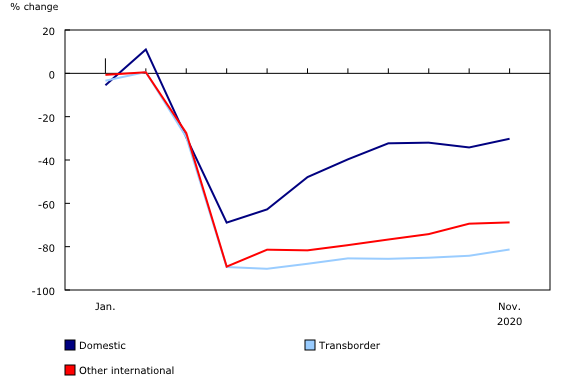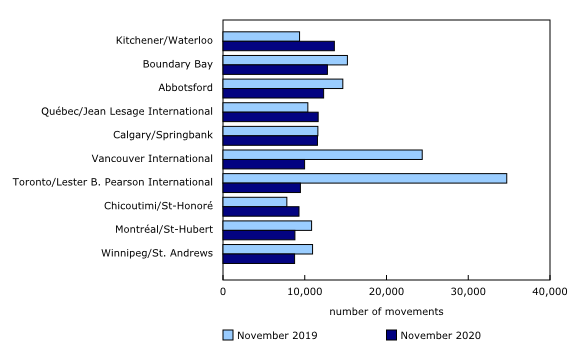Aircraft movement statistics: Major airports, November 2020
Archived Content
Information identified as archived is provided for reference, research or recordkeeping purposes. It is not subject to the Government of Canada Web Standards and has not been altered or updated since it was archived. Please "contact us" to request a format other than those available.
Released: 2021-01-29
318,388
November 2020
-26.6% 
(year-over-year change)
Highlights
In November, the total number of aircraft movements in Canada fell 26.6% from November 2019.
Domestic traffic (within Canada) declined 30.2% from November 2019, while movements to the United States were down 81.3%. Other international traffic dropped 68.8% year over year and remained flat compared with October (-69.4%).
Kitchener/Waterloo in Ontario was Canada's busiest airport in November—the first time since recordkeeping began 60 years ago—with 13,619 take-offs and landings.
Itinerant movements at Hamilton International in Ontario increased year over year (+0.4%) for the first time since the onset of the pandemic, supported by cargo movements. The airport also reported a surge in helicopter movements, shuttling Canadian snowbirds over the US–Canada border.
Aircraft movements slump towards year's end
Eight months after first plummeting in response to measures imposed to curb the spread of COVID-19, air traffic remained well below pre-pandemic levels in November. The trifecta of a resurgence of cases of COVID-19, ongoing border restrictions, and a lack of consumer demand contributed to holding total aircraft movements at Canada's major airports at roughly three-quarters of the level reported the year before.
There were 318,388 take-offs and landings at the 90 Canadian airports with NAV CANADA air traffic control towers and flight service stations, compared with 433,748 in November 2019. Itinerant movements (flights from one airport to another) declined 38.5% year over year to 181,428 in November, while local movements (flights that remain in the vicinity of the airport) were down 1.4% to 136,960.
Domestic traffic (within Canada) declined 30.2% from November 2019. Although recovery in domestic movements has continued to outperform international movements, the pace has slowed since August. Transborder movements (flights to the United States) fell 81.3% compared with November of last year, while other international movements fell 68.8%, largely unchanged from the previous month's decrease (-69.4%).
Cargo continues to be a bright spot
Hamilton International is Canada's busiest overnight express cargo hub. After the onset of travel restrictions, total traffic at Hamilton International fell to its lowest point in May (-62.1%). As passenger service faltered, activity was bolstered by the movement of essential medical supplies and goods from increased e-commerce sales. In November, the airport had recorded its first year-over-year increase in itinerant movements since the onset of the pandemic (+0.4%).
Cargojet, a long-standing partner of the airport, noted that the surge in volumes that began in March and April had already exceeded typical peak-season volumes. Furthermore, they expected to move even more cargo through the holiday season.
Second-quarter results for level I and II carriers show that goods revenue increased 46.6% and more recent data on retail e-commerce sales show an unadjusted year-over-year increase of 75.9% in November.
Snowbirds take off from Hamilton International
With restrictions against non-essential land-border crossings to the US, snowbirds eager to travel by motor vehicle were provided with a new option—i.e., via Hamilton International—to reach their southern destinations. A helicopter service was initiated in late October, which shuttles individuals across the border to Buffalo, New York while their vehicles are transported overland. In November, helicopter traffic at the airport was almost four times higher than the previous five-year average for November.
Canada's busiest airports
In November, 10 airports accounted for just over one-third of all aircraft movements (34.0%). Kitchener/Waterloo, in Ontario, was Canada's busiest airport with 13,619 take-offs and landings—the first time the airport has claimed the top spot since records keeping began in 1960. Boundary Bay and Abbotsford—both in British Columbia—rounded out the top three with 12,773 and 12,307 movements, respectively.
Looking ahead
On December 13, 2020, an aircraft carrying the first shipment of COVID-19 vaccines touched down in Canada. While this is an encouraging step forward, the unpredictable nature of COVID-19 continues to challenge the aviation industry. For example, on December 23, Canada suspended all flights from the United Kingdom after a new variant of COVID-19 was identified, and the ban continued until January 6, 2021.
Furthermore, the Canadian government announced that, effective January 7, 2021, air passengers aged five and older would require proof of negative COVID-19 test result before entering Canada. WestJet and Air Canada subsequently announced additional staff and service reductions for the first quarter of 2021. At the same time, Porter Airlines announced it would delay its restart further until March 29, 2021.
Note to readers
This survey collects data on itinerant and local aircraft movements at major airports in Canada.
Major airports include all airports with either a NAVCANADA air traffic control tower or a NAVCANADA flight service station.
On November 5, 2020, NAVCANADA recognized the increase in air traffic at Red Deer Regional Airport in Alberta prior to the COVID-19 pandemic and changed its status from a flight service station to offer air traffic control service at the airport for 16 hours per day. As a result, effective November 1, 2020, monthly aircraft movement data for the airport are available in tables 23-10-0002-01 to 23-10-0008-01 (airports with NAVCANADA towers). Data prior to November 2020 remain available in tables 23-10-0009-01 to 23-10-0015-01 (airports with NAVCANADA flight service stations).
On January 30, 2020, NAVCANADA air traffic control service was re-established at Montréal/Mirabel International in Quebec for 16 hours per day. In 2008, because of a reduction in traffic levels, air traffic control service at the airport was replaced by a flight service station. As a result, effective February 1, 2020, monthly aircraft movement data for the airport reverted to tables 23-10-0002-01 to 23-10-0008-01 (airports with NAVCANADA towers). Data from December 2008 to January 2020 remain available in tables 23-10-0009-01 to 23-10-0015-01 (airports with NAVCANADA flight service stations).
An aircraft movement is defined as a take-off, landing or simulated approach by an aircraft, as defined by NAVCANADA.
Data for the same month in the previous year may have been revised.
The data in this monthly release are not seasonally adjusted.
Contact information
For more information, or to enquire about the concepts, methods or data quality of this release, contact us (toll-free 1-800-263-1136; 514-283-8300; STATCAN.infostats-infostats.STATCAN@canada.ca) or Media Relations (613-951-4636; STATCAN.mediahotline-ligneinfomedias.STATCAN@canada.ca).
- Date modified:





